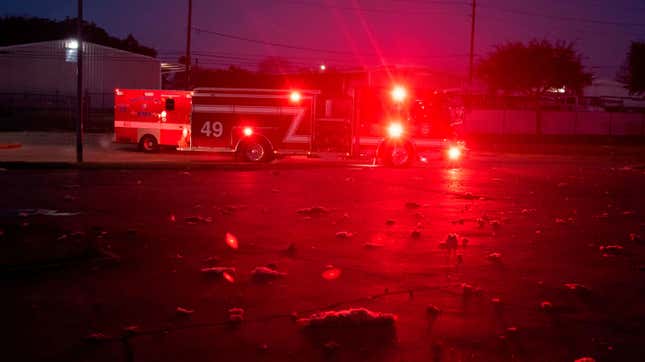
A massive blast at an industrial facility in the 4500 block of Gessner Road in northwest Houston killed at least two people, Houston Police Chief Art Acevedo told reporters hours later on Friday.
The explosion shook the city for miles, according to CNN, resulting in at least one person being sent to the hospital and doing damage to structures at least half a mile away. Per KPRC, it leveled a machine shop called Watson Valve Services (also referred to by Reuters as Watson Grinding and Manufacturing), with the extensive damage to homes “including blown-out windows, damaged garage doors and more.” Resident Mark Brady told the station that the blast “knocked us all out of our bed, it was so strong” and “busted out every window in our house.”


“It busted everybody’s garage door in around here... and closer toward the explosion over here, it busted people’s roofs in and walls in, and we don’t know what it is,” Brady added. “…It’s a warzone over here.” Another resident, Kim, told Click2Houston their roof collapsed and the “whole house is ruined... It’s trashed. It’s just trashed.”
Video from a local resident’s security camera shows the blast lighting up the night sky at around 4:24 a.m. local time before the camera itself was knocked from its mounting. Acevedo told reporters that polypropylene, a tough, cheap thermoplastic, was burning and emitting fumes into the air but that authorities expected it to dissipate quickly.
Fox 26 meteorologist Mike Iscovitz tweeted that the explosion was powerful enough to show up on local radar, something he’d never seen before.
The cause of the explosion at the facility was not immediately clear. Reuters reported that Acevedo said police were opening up a criminal investigation, though “Having said that, when you have this kind of a type of incident, part of our protocol is to always conduct a criminal investigation.”
Debris was strewn for at least half a mile, Acevedo tweeted.
“This is still an active scene,” Houston Fire Chief Samuel Peña tweeted. “Avoid the area. No evacuation order given at this time. We will advise of the possible cause of the explosion as soon as we have concrete info.”
Houston is a major gas and oil hub and the region has a long history of industrial accidents, including two fires at an ExxonMobil facility last year (one of which injured 37 people), a multi-day fire at a Intercontinental Terminals Co. chemical storage facility in March 2019 that leaked huge amounts of toxin and sent hundreds seeking treatment for benzene exposure, and a 2005 disaster at a BP refinery in Texas City that killed 15 and injured 180 others.
Hurricane Harvey hit the region hard in August 2017, hitting black and Latino communities the hardest and flooding or damaging 13 heavily contaminated Superfund sites. One site, a toxic waste pit leaking dioxins, furans, and polychlorinated biphenyls into the San Jacinto River, only saw cleanup begin the next year. Houston’s air quality is among the worst in the nation, which Air Alliance Houston blames in part on lax enforcement by the Texas Commission on Environmental Quality and thousands of industrial emission events. Activist Erin Brockovich recently joined residents of the city’s Fifth Ward in calling for an investigation into a state-identified cancer cluster in the neighborhood.